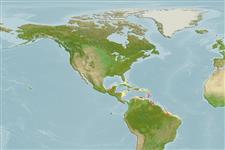Niphates caycedoi (Zea & van Soest, 1986)
| Native range | All suitable habitat | Point map | Year 2050 |

|
| This map was computer-generated and has not yet been reviewed. |
| Niphates caycedoi AquaMaps Data sources: GBIF OBIS |
Upload your photos
Google image |
No photo available for this species.No drawings available for Niphatidae.
Google image |
No photo available for this species.
Classification / Names Common names | Synonyms | CoL | ITIS | WoRMS
Demospongiae | Haplosclerida | Niphatidae
Environment: milieu / climate zone / depth range / distribution range Ecology
Sessile; brackish; depth range 1 - 15 m (Ref. 108813). Tropical
Distribution Countries | FAO areas | Ecosystems | Occurrences | Introductions
Western Central Atlantic.
Length at first maturity / Size / Weight / Age
Maturity: Lm ? range ? - ? cm Max length : 6.0 cm OT male/unsexed; (Ref. 415)
Short description Morphology
Thick crusts: 2 - 6 cm in thickness, with compound oscules, 0.3 - 0.6 cm in diameter on top of low mounds. Grayish-blue externally, lighter to tan internally. Surface punctuated with or without white zooanthids Parazoanthus sp. Hard-compressible in consistency (Ref. 415).
Maximum body thickness: 6 cm (Ref. 415).
Life cycle and mating behavior Maturity | Reproduction | Spawning | Eggs | Fecundity | Larvae
Members of the class Demospongiae are hermaphroditic. Life cycle: The zygote develops into parenchymella larva (free-swimming) before settling down on a substrate where it grows into a young sponge.
Main reference
References | Coordinator | Collaborators
Collin, R., M.C. Díaz, J. Norenburg, R.M. Rocha, J.A. Sánchez, M. Schulze, A. Schwartz and A. Valdés. 2005. (Ref. 415)
IUCN Red List Status (Ref. 130435: Version 2024-1)
CITES status (Ref. 108899)
Not Evaluated
CMS (Ref. 116361)
Not Evaluated
Threat to humans
Harmless
Human uses
| FishSource |
Tools
More information
Trophic Ecology
Food items
Diet
Food consumption
Ration
Predators
Diet
Food consumption
Ration
Predators
Ecology
Population dynamics
Life cycle
Distribution
Human Related
Aquaculture profile
Stamps, Coins Misc.
Stamps, Coins Misc.
Outreach
References
Internet sources
BHL | BOLD Systems | CISTI | DiscoverLife | FAO(Publication : search) | Fishipedia | GenBank (genome, nucleotide) | GloBI | Gomexsi | Google Books | Google Scholar | Google | PubMed | Tree of Life | Wikipedia (Go, Search) | Zoological Record
Estimates based on models
Preferred temperature
(Ref. 115969): 27 - 28.5, mean 27.7 (based on 101 cells).
Price category
(Ref. 80766):
Unknown.


